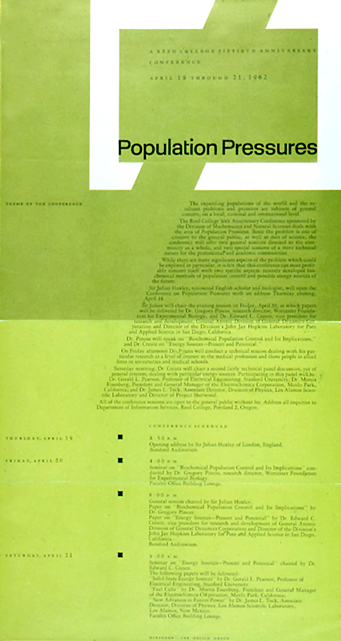Irwin McFadden was a designer and typographer and husband of designer/artist Ellen McFadden. Below are a collection of images, graphics, letters and articles from a variety of sources.
This entry is incomplete. If you have more to add to this entry, or a recommendation on who we should feature on Portland Design History, please reach out to: melissa@meldel.com.


Modernist Graphic Design in the Pacific Northwest:
Tracing Designers and Influence
By Sean Wolcott, originally published in "Arcade", March 3, 2015 Today, the graphic design profession thrives in the Pacific Northwest after rising in prominence over the last 30 years. Throughout the latter part of the 20th century, graphic design rapidly transitioned from the illustration-based world of advertising to a practice with its own identity. European modernists helped influence this new way of designing, and as this approach began to take hold in key European cities, it soon spread to the Americas in New York, Chicago, Brazil and Canada. In Seattle and Portland these ripples were much smaller, though just as strongly felt by a small group of like-minded designers.
The graphic arts have been intertwined with commerce for thousands of years, serving as a key means of identifying and differentiating one’s products and communications from those of the competition. This theme continued as a new approach to creating visual material dawned in the 20th century, a more formalized practice that diverged from the fine arts; the notion of what we now commonly know as “graphic design” was just taking shape. The Bauhaus movement in Weimar, Germany, with Walter Gropius, Mies van der Rohe, Marcel Breuer, Herbert Bayer, Josef and Anni Albers and many others approached design from a holistic perspective, encompassing graphics, architecture, products and clothing. With the onset of WWII, many Bauhaus teachers were forced to migrate to other parts of Europe as well as the United States, broadening their influence.

For Portland designer Ellen McFadden, now in her 80s, and her husband Irwin McFadden, this European-influenced modernism was a revelation. “Directly after WWII there was no real advertising art—known today as graphic design—curriculum in any Oregon schools that I remember. What we young design turks followed was our own discoveries through international publications such as pre-war fashion magazines, [designers] Alexey Brodovich [and] Herbert Bayer, WWII posters and anything the Container Corporation produced, along with Binder’s work for the New York World’s Fair [in] 1939 and Knoll furniture ads.”
McFadden studied under Doug Lynch at the Pacific Northwest College of Art.
Lynch, she notes, “was the top freelance graphic designer—at that time called an advertising artist—in Portland in the immediate years following WWII. Doug was an advocate of Paul Rand, and [his] work was very new by older Pacific Northwest pre-war and immediate post-war standards. Doug Lynch brought the concept of design to Portland advertising.”
In 1958, the Swiss publication of Neue Grafik (available in English, French and German) had a profound impact on designers embracing this new modernism across the globe. McFadden recalls that “an announcement for the New Graphic Design magazine came from Zurich, Switzerland. There had been many new graphic design publications, books especially, being published in Europe and the US that we bought and devoured. But this magazine was very different.” She suggests that “this series changed our lives and design direction forever.” In 18 issues, published through 1965, the magazine’s editors Josef Müller-Brockmann, Richard Paul Lohse, Hans Neuburg and Carlo Vivarelli presented some of the most vibrant and essential modernist works of the time.

This new graphic design, built on the thoughts and experiments of the earlier part of the century, reached an apex of sorts in works that were visually powerful, intellectually elegant and rigorous in their communication. The persuasive approach of typical advertising art was discarded, and a dramatic presentation of information was embraced. The objective was sought over the subjective, and designs consisted primarily of simple, strong typography and photographic images, demonstrating (along with a wide range of intelligent discourse) that graphic design could be brought to a minimalist state, encompassing both form and function.
Experiencing this enlightenment regarding how to approach design, Ellen McFadden states that not everyone was eager to embrace this method for their own communications.
“My husband and I lost clients because we refused to go back to the old advertising. The biggest problem at first was that clients just did not see the new graphic design vision at all. Very little design work could be freelanced in that direction at that time. It was later, especially through the University of Washington’s graphic design program, that it became the vision of today in the Seattle area.”
As such, today things are much different. An unembellished and clear way of designing has been adopted and embraced by many, and the design principles introduced in the early years of modernist graphic design have proved equally relevant over 50 years later. In the Northwest offices of tech companies and many others, such pure and powerful design continues to evolve and prove its value in physical as well as new digital spaces.
Sean Wolcott is a Seattle-based graphic designer, currently working as a senior art director at Microsoft, where he creates user interfaces and experiences for products used by millions. In addition, Wolcott runs his own practice, Rationale, where he designs identities, packaging, signage, publications, websites and user interfaces for a wide array of clients.


Learning about Type with Irwin McFadden
By Roger Bachman, as told to Tim Leigh
December 4, 2011
In the early ‘60’s, I got to know Irwin McFadden, who was designing literature for a furnace manufacturing company, one you never heard of. McFadden called me wanting a bid on the printing of this literature. But he said, “I don’t care for this guy much, and I don’t like having to go clear out to the east side to service the business.” So, I took over the account. I solved a problem for McFadden — all he wanted to do was the design — and got the printing business for myself.
One time, Irwin took me to a weeklong seminar on calligraphy, presented by Arnold Bank, not only a brilliant letter artist, but also a compelling lecturer. It was one of the best things I ever did; really opened my eyes. This was before the days of felt markers, but Bank would trim felt to fit down in the neck of an ink bottle, and use it to draw big letterforms on butcher paper. His own idea. He was a little, pop-eyed guy, a dynamo. It was the first time I’d ever looked at letters as design; gave me the idea to use the A from Arcady Press, stylized, as a logo. And after that I was able to intelligently discuss letterforms with McFadden, Doug Lynch, Byron and others. I (and they) appreciated that.
Assorted design pieces by Irwin McFadden
















留言